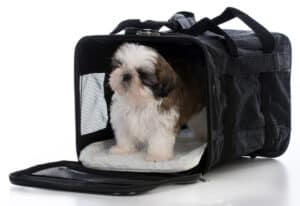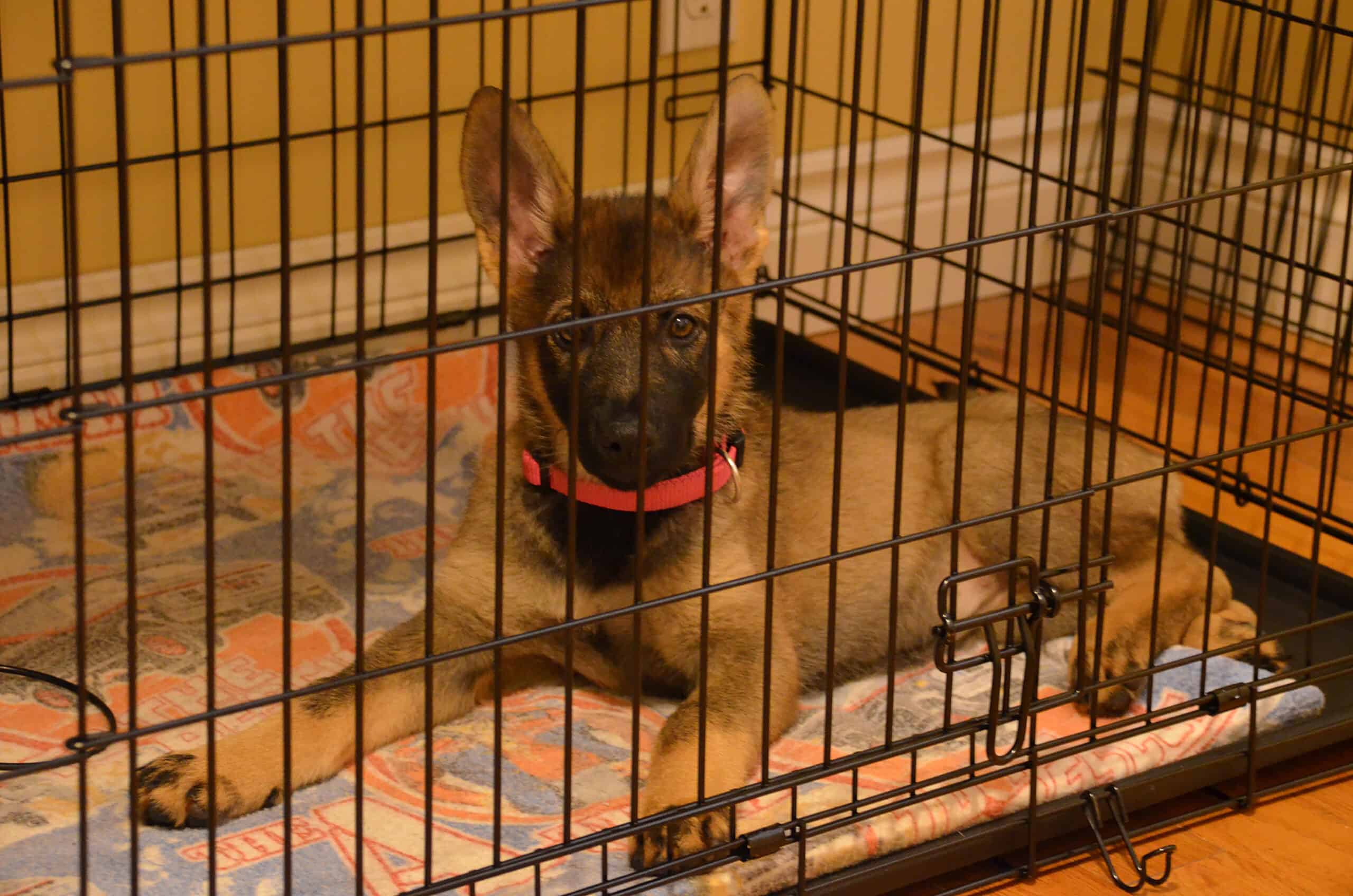Crate training a puppy can be an effective way to teach your new friend how to behave when you’re not around.
It can help prevent destructive behavior, ease separation anxiety, and keep your puppy safe when you’re not able to supervise them.
However, crate training can be a daunting task for first-time puppy owners.
Fortunately, crate training a puppy is a relatively simple process that can be broken down into a few easy steps.
Before you start, it’s important to choose the right crate for your puppy.
The crate should be large enough for your puppy to stand up, turn around, and lie down comfortably.
If the crate is too small, your puppy may feel cramped and uncomfortable. If it’s too large, your puppy may be tempted to use one end as a bathroom.
Once you’ve chosen the right crate, you can start the crate training process.
In this article, we’ll guide you through the process of crate training a puppy, step-by-step.
We’ll cover everything from choosing the right crate to making the crate a comfortable and welcoming space for your puppy.
By the end of this article, you’ll have all the tools you need to successfully crate train your puppy. So, grab a treat and let’s get started!
Understanding Crate Training
Crate training is a popular method of housebreaking puppies and adult dogs.
It involves teaching your dog to view a crate as a safe and comfortable den where they can relax and sleep.
In this section, we’ll explore the benefits of crate training and the psychology behind it.
Benefits of Crate Training
Crate training has many benefits for both you and your puppy. It provides your puppy with a safe space where they can retreat when they feel overwhelmed or anxious.
A crate can also help prevent destructive behavior, such as chewing or digging, by keeping your puppy contained when you’re not able to supervise them.
In addition, crate training can make housebreaking your puppy much easier.
Dogs instinctively avoid soiling their den, so a properly sized crate can help your puppy learn to hold their bladder and bowels.
It can also help you establish a routine for feeding and potty breaks, which can make housebreaking faster and more effective.
The Psychology Behind Crating
Crate training is based on the natural instincts of den animals, such as dogs.
In the wild, den animals seek out small, enclosed spaces where they can feel safe and secure.
By providing your puppy with a crate, you’re giving them a den of their own where they can feel protected and comfortable.
It’s important to note that crate training should never be used as a form of punishment.
Your puppy should view their crate as a positive, safe space, not a place where they’re sent when they’ve misbehaved.
With patience and consistency, you can help your puppy learn to love their crate and view it as a cozy retreat.
Selecting the Right Crate
When it comes to crate training your puppy, selecting the right crate is crucial.
There are different types of crates available on the market, and choosing the one that best suits your puppy’s needs can make all the difference in the success of the training.
Types of Crates


There are three main types of crates: plastic, wire, and fabric.
Plastic crates and wire crates are sturdy and durable, making them a good option for puppies that may chew through fabric. They are also easy to clean and maintain.
Fabric crates, on the other hand, are lightweight and collapsible, making them easy to transport and store.
They are also more comfortable for puppies to lie in, as they are made from softer materials.
Determining the Correct Size
It’s important to choose a crate that is the right size for your puppy.
A crate that is too small will be uncomfortable for your puppy, while a crate that is too large may encourage your puppy to use one end as a bathroom and the other end as a sleeping area.
To determine the correct size, measure your puppy from the tip of their nose to the base of their tail, and add a few inches to that measurement.
This will give you the length of the crate. Next, measure your puppy from the floor to the top of their head, and add a few inches to that measurement.
This will give you the height of the crate.
When selecting a crate, keep in mind that your puppy will grow quickly, so you might want to consider a crate that has a divider panel that can be adjusted as your puppy grows.
This will allow you to make the crate smaller when your puppy is small, and larger as they grow.
If you choose a fabric crate, make sure it is sturdy enough to withstand your puppy’s chewing and scratching.
Overall, selecting the right crate is an important step in crate training your puppy.
By choosing a crate that is the right size and type for your puppy’s needs, you can create a comfortable and safe space for them to rest and relax in.
Setting Up the Crate
Before you begin crate training your puppy, you need to set up the crate properly. This will help your puppy feel comfortable and safe in their new space.
Comfortable Bedding
The first thing you need to do is add some comfortable bedding to the crate. This can be a soft blanket or a few blankets layered on top of each other.
Make sure the bedding is clean and free of any loose threads or holes that your puppy could get tangled in.
You want your puppy to have a cozy and inviting space to sleep in.
Placement in the Home
The placement of the crate in your home is also important. You want to choose a location that is quiet and free from distractions.
Avoid placing the crate in high traffic areas like the kitchen or hallway. Instead, choose a quiet corner of a room where your puppy can feel safe and secure.
Once you have chosen the perfect spot for the crate, you can start introducing your puppy to their new space.
Leave the door open and allow your puppy to explore the crate on their own. You can place some safe toys inside the crate to encourage your puppy to go in and out of the space.
Remember, crate training takes time and patience. By setting up the crate properly, you are creating a comfortable and safe space for your puppy to call their own.
Introducing Your Puppy to the Crate
Here are some tips to make the process easier.
Creating Positive Associations
The first step in introducing your puppy to the crate is to create positive associations. Make sure the crate is a comfortable and inviting space for your puppy.
Put a soft blanket or towel inside the crate and add a favorite toy. You can also place treats inside the crate to encourage your puppy to explore.
The First Time in the Crate
The first time you put your puppy in the crate, make sure they are relaxed and calm. You can use treats to encourage them to go inside the crate.
Once your puppy is inside, close the door and stay nearby. Talk to your puppy in a calm and reassuring voice to help them feel comfortable.
You can also offer treats through the door to help create positive associations with the crate.
It’s important to remember that crate training takes time and patience. Don’t rush the process and always make sure your puppy is comfortable and happy.
With consistent training and positive reinforcement, your puppy will learn to love their crate and see it as a safe and comfortable space.
Crate Training Routine
Establishing a consistent routine is crucial for successful crate training. Puppies need structure and predictability to feel secure and confident.
Here are some tips for establishing a crate training routine that works for you and your puppy.
Daily Schedule
Create a daily schedule that includes regular feeding times, exercise, playtime, and nap time.
Puppies have a lot of energy, so it’s important to provide them with plenty of opportunities to burn it off.
Take your puppy for a walk or play a game of fetch before crate time to help them relax.
It’s also important to establish a consistent bedtime routine. Puppies need plenty of sleep, so make sure they have a quiet, comfortable place to rest.
A crate can provide a safe and cozy sleeping environment for your puppy.
Feeding and Exercise
Establish a feeding schedule that works for you and your puppy. Puppies should be fed three to four times a day, with the last meal given a few hours before bedtime.
Make sure your puppy has access to water at all times, but remove the water bowl a few hours before bedtime to prevent accidents.
Exercise is also important for your puppy’s physical and mental health. Take your puppy for a walk or play a game of fetch before crate time to help them relax.
Avoid vigorous exercise right before bedtime, as this can make it harder for your puppy to settle down.
Crate Training Schedule
Establish a consistent crate training schedule that includes short periods of time in the crate throughout the day.
Start with just a few minutes at a time and gradually increase the duration as your puppy becomes more comfortable.
Make sure your puppy has plenty of toys and treats to keep them occupied while they are in the crate.
Never force your puppy into the crate or use it as a punishment. The crate should be a positive and safe space for your puppy.
With patience and consistency, your puppy will learn to love their crate and see it as a cozy den.
By establishing a consistent routine and following a crate training schedule, you can help your puppy feel safe, secure, and comfortable in their crate.
Remember to be patient and consistent, and always reward good behavior with plenty of praise and treats.
Dealing with Whining and Anxiety
Crate training a puppy can be challenging, especially when they whine or show signs of anxiety.
However, it is important to understand that whining and anxiety are normal behaviors for puppies, especially when they are separated from their owners.
Understanding Puppy Anxiety
Anxiety in puppies can occur due to several reasons such as fear, separation anxiety, or lack of socialization.
Signs of anxiety include excessive barking, destructive behavior, and whining.
If your puppy shows signs of anxiety, it is important to address the issue before it becomes a bigger problem.
One way to prevent anxiety in puppies is to make crate training a positive experience.
You can do this by placing treats and toys in the crate and encouraging your puppy to enter it voluntarily.
Additionally, you can provide a comfortable bed or blanket to make the crate feel like a safe and secure space.
Preventing and Reducing Whining
Whining is a common behavior in puppies, especially when they are first introduced to a crate.
However, it is important to address whining to prevent it from becoming a habit.
One way to prevent whining is to gradually increase the amount of time your puppy spends in the crate.
Start with short intervals and gradually increase the time as your puppy becomes more comfortable.
Additionally, you can provide a distraction such as a toy or treat to keep your puppy occupied while in the crate.
If your puppy continues to whine, it is important to remain calm and avoid giving in to their demands. Giving attention to a whining puppy will only reinforce the behavior.
Instead, wait for your puppy to stop whining before providing attention or letting them out of the crate.
In conclusion, whining and anxiety are normal behaviors in puppies, especially during crate training.
However, with patience and consistency, you can prevent and reduce these behaviors, making crate training a positive experience for both you and your puppy.
Crate Training Challenges
Crate training a puppy can be challenging, especially if you’re doing it for the first time.
However, with patience and consistency, you can overcome any obstacles that come your way.
Here are some common crate training challenges and how to address them.
Addressing Accidents
One of the biggest challenges of crate training is dealing with accidents. Puppies have small bladders and may not be able to hold their pee for long periods.
If your puppy has an accident in the crate, don’t punish them. Instead, clean up the mess and remove any soiled bedding.
Use an enzymatic cleaner to eliminate any odors that may attract your puppy to the same spot.
To prevent accidents, make sure you take your puppy outside to potty before placing them in the crate.
You should also limit your puppy’s water intake before bedtime and during crate time.
If your puppy continues to have accidents, you may need to adjust the crate size or the duration of time they spend in the crate.
Managing Chewing and Destruction
Puppies love to chew, and they may try to chew on their crate. To prevent this, make sure you give your puppy plenty of chew toys to keep them occupied.
You can also use bitter apple spray on the crate to discourage chewing.
If your puppy is still chewing on the crate, you may need to adjust the crate size or the type of crate you’re using.
Some puppies prefer plastic crates, while others prefer wire crates.
You may also need to provide more exercise and mental stimulation to help your puppy release their energy.
In conclusion, crate training challenges are common, but they can be overcome with patience and consistency.
Addressing accidents and managing chewing and destruction are two of the most common challenges you may face.
By following the tips outlined above, you can help your puppy become comfortable and confident in their crate.
Advanced Crate Training Concepts
Crate training is an essential part of puppy training, but it can also be used for adult dogs.
If you have an older dog that has never been crate trained, it can be a little more challenging, but it is still possible. Here are some tips for crate training older dogs.
Crate Training Older Dogs
When crate training an older dog, it is essential to take things slowly. Start by introducing the crate to your dog and let them explore it.
Place some treats and toys inside the crate to make it more inviting. Once your dog is comfortable being near the crate, start feeding them meals near the crate.
Gradually move the food closer to the crate until your dog is eating inside the crate.
Once your dog is comfortable eating inside the crate, start closing the door for a few seconds while they eat.
Gradually increase the amount of time the door is closed until your dog is comfortable being in the crate for longer periods.
Remember to praise and reward your dog for being calm and relaxed in the crate.
Using Crates for Transportation
Crates can also be used for transportation, but it is important to make sure your dog is safe and comfortable.
When traveling by car, make sure the crate is secured and cannot move around. You can use a seatbelt or secure the crate to the car using straps.
Make sure your dog has access to water and is comfortable inside the crate. You can place a blanket or towel inside the crate to make it more comfortable.
If your dog has never been in a crate before, start by introducing them to the crate at home before using it for transportation.
In case of an emergency evacuation, having a crate ready can be essential for your dog’s safety.
Make sure the crate is easily accessible and your dog is comfortable being inside it for extended periods.
It is also a good idea to have your dog’s food, water, and medications packed and ready to go in case of an emergency.
Overall, crate training is an essential part of puppy training, but it can also be used for adult dogs. When crate training older dogs, take things slowly and be patient.
Crates can also be used for transportation, but make sure your dog is safe and comfortable.
In case of an emergency evacuation, having a crate ready can be essential for your dog’s safety.
When Not to Crate Your Puppy
Crate training can be a great tool for house training and providing your puppy with a safe space. However, it’s important to know when not to use the crate.
In this section, we’ll discuss some situations where crate training may not be appropriate.
Avoiding Overuse of the Crate
While crate training can be helpful, it’s important not to overuse it.
Puppies need plenty of exercise and socialization, and spending too much time in a crate can be detrimental to their development.
It’s recommended that puppies not be crated for more than a few hours at a time, and never for more than 4-5 hours at a stretch.
Recognizing Signs of Distress
It’s also important to recognize when your puppy is distressed in the crate.
While some whining and crying is normal when first introducing your puppy to the crate, persistent barking, panting, or drooling may indicate that your puppy is uncomfortable.
If your puppy seems distressed in the crate, it may be time to reevaluate your crate training plan.
Additionally, it’s important to never use the crate as punishment.
The crate should always be a safe and positive space for your puppy, and using it as a form of punishment can cause anxiety and fear.
In summary, while crate training can be a helpful tool for house training and providing your puppy with a safe space, it’s important to use it appropriately and recognize when it may not be appropriate.
Avoid overuse of the crate, recognize signs of distress, and never use the crate as punishment.
Resources and Professional Help
Crate training a puppy can be a challenging task, and you may need some professional help to get it right.
Here are some resources that can help you get started.
Consulting a Dog Trainer

If you’re having trouble crate training your puppy, consulting a professional dog trainer can be a great option.
A dog trainer can assess your puppy’s behavior and provide you with personalized advice and training techniques.
They can also help you determine the best type of crate for your puppy and how to introduce them to the crate.
The AKC has a database of certified trainers that you can search by location. You can also find dog trainers through the GoodDog! Helpline, which provides free advice and referrals to dog trainers and behaviorists.
Online Guides and E-Books
If you prefer a DIY approach, there are many online guides and e-books available that can help you crate train your puppy.
These resources can provide you with step-by-step instructions, tips, and advice on crate training.
The AKC offers a comprehensive guide to crate training, which includes information on crate selection, crate training techniques, and troubleshooting common problems.
You can also find e-books on crate training from reputable sources like Amazon and Barnes & Noble.
When selecting an online guide or e-book, be sure to choose one from a reputable source with positive reviews.
It’s also a good idea to look for resources that are specific to your puppy’s breed and age, as different breeds and ages may require different training techniques.
Remember, crate training is a process that takes time and patience.
With the right resources and professional help, you can successfully crate train your puppy and provide them with a safe and comfortable space of their own.
Frequently Asked Questions
What is the best schedule for crate training a puppy?
The best schedule for crate training a puppy is to start slowly and gradually increase the time your puppy spends in the crate.
According to All Things Dogs, you can start by placing your puppy in the crate for short periods of time while you are at home.
Then, you can gradually increase the time your puppy spends in the crate while you are away.
It is also important to establish a routine for your puppy, including regular feeding and exercise times.
Can crate training have negative effects on my puppy?
Crate training, when done properly, does not have negative effects on your puppy.
In fact, it can help your puppy feel safe and secure, according to Rogue Pet Science.
However, if you use the crate as a form of punishment or leave your puppy in the crate for extended periods of time, it can have negative effects on your puppy’s mental and physical health.
How can I comfort my puppy when it cries in the crate?
When your puppy cries in the crate, it can be tempting to let them out or comfort them.
However, this can reinforce negative behavior and make it harder to crate train your puppy.
Instead, try placing a blanket or toy in the crate that smells like you, according to American Kennel Club.
You can also try playing calming music or leaving a light on to help your puppy feel more comfortable.
Is it recommended to crate a puppy during the night?
Yes, it is recommended to crate a puppy during the night.
According to All Things Dogs, crating your puppy at night can help prevent accidents and establish a routine for your puppy.
However, it is important to make sure your puppy has access to water and has gone to the bathroom before being placed in the crate for the night.
At what age should I start and stop crate training my dog?
You can start crate training your puppy as early as 8-12 weeks old, according to American Kennel Club.
However, the length of time your puppy spends in the crate should be adjusted based on their age and ability to hold their bladder.
You should stop crate training your dog when they no longer need the crate for safety or security reasons.
What are the alternatives to crate training for a puppy?
There are several alternatives to crate training for a puppy, including using a playpen or designating a safe area of your home for your puppy to stay in, according to All Things Dogs.
However, crate training can be an effective way to establish a routine and provide your puppy with a safe and secure space.
It is important to choose the method that works best for you and your puppy.

